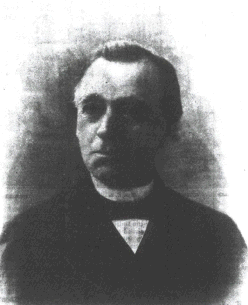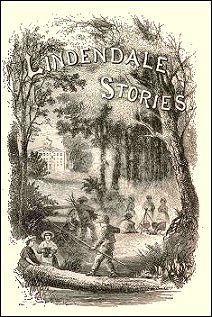
Daniel Wise (Francis Forrester, Lawrence Lancewood)
Born 10 January 1813 in Portsmouth, England, Daniel Wise emigrated to the United States in 1833. The NCAB notes that he "began to prepare himself for the Methodist Episcopal ministry" and "held various pastorates during 1837-52". [1] He also acquired a D. D. from Wesleyan University, Middletown, Connecticut, in 1859. (The Wise Prize at Wesleyan, "for excellence in the Department of Philosophy; for the best essay on moral science on some subject in the field or values" is his endowment.[2]) Much of his career, however, concerned writing and publishing, primarily of religious (or religiously-oriented) material. From 1838 to 1844, he edited and published the Sunday-School Messenger, the first Methodist Sunday school paper in the U.S. During this period, Wise also began writing books: Life of Lorenzo Dow in 1840 and History of London in 1841. Numerous other titles, many published pseudonymously, soon followed. In 1852, he assumed the editorship of Zion's Herald in Boston. His tenure with the Herald ended in 1856, when he instead took on the editorship of the Methodist Episcopal church's Sunday-school publications; in 1860, he also became editor of the church's tract publications, and held these positions until 1872.
 His first children's series, the twelve-volume My Uncle Toby's Library, issued under the penname Francis Forrester, appeared in 1853; these were small volumes, usually about 62 pages, with large print and illustrations throughout. A second series involving longer works, the five-volume Glen Morris Stories as by Lawrence Lancewood, Esq., was published from 1859-1862. He followed this with the five-volume Lindendale Stories and six-volume Hollywood Stories from 1865-1868 and 1872-1874, respectively, both under the Forrester pseudonym. A final series, the four-volume Winwood Cliff, appeared from 1876-80 under Wise's own name.
His first children's series, the twelve-volume My Uncle Toby's Library, issued under the penname Francis Forrester, appeared in 1853; these were small volumes, usually about 62 pages, with large print and illustrations throughout. A second series involving longer works, the five-volume Glen Morris Stories as by Lawrence Lancewood, Esq., was published from 1859-1862. He followed this with the five-volume Lindendale Stories and six-volume Hollywood Stories from 1865-1868 and 1872-1874, respectively, both under the Forrester pseudonym. A final series, the four-volume Winwood Cliff, appeared from 1876-80 under Wise's own name.
Most of Wise's series employed a similar structural pattern, featuring a group of children who appear as main characters in one or more books and supporting characters in other stories within the series. All are heavily didactic. My Uncle Toby's Library also incorporates a great deal of informational material in some volumes; for example, Minnie's Playroom; or, How to Practice Calisthenics, is largely a book about exercise, complete with diagrams and instructions, under the guise of a lightweight tale about a young girl receiving a fully-fitted exercise room -- complete with instructor -- from her father. Minnie Brown, its protagonist (who also stars in Minnie Brown and Minnie's Pic-Nic [sic], two other volumes in the series) appears in a lesser role in other books, such as Arthur's Triumph; or, Goodness Rewarded, where she arranges a party for Arthur when he is accepted into Belmont Academy and coordinates a plan by his schoolmates to buy him an expensive Bible as a going-away present.
Wise's philosophy about his children's books is made clear in the prefatory note to each volume of the Glen Morris stories. He explains their
"purpose is to sow the seed of pure, noble, manly character in the mind of our great nation's childhod. They exhibit the virtues and vices of childhood, not in prosy, unreadable precepts, but in a series of characters which move before the imagination as living beings do before the senses. Thus access to the heart is won by way of the imagination. While the story charms, the truth sows itself in the conscience and the affections. The child is thereby led to abhor the false and the vile, and to sympathise with the right, the beautiful, and the true." [emphasis added]
The series title comes from its location -- the Glen Morris farm, located in Duncanville -- which is occupied by the Carleton family, two of whose children, Guy and Jessie, are the title characters of the first and third volumes. The stories also incorporate the adventures of the Carletons' neighbors, Dick Duncan and Walter Sherwood (title characters of the second and fourth volumes) and their cousin, Kate Carleton, introduced in the second volume and title character of the fifth book. In similar fashion, Lindendale Stories, dedicated "To every girl who aspires to grow into an upright and noble woman, and to every boy who wishes to become a true and excellent man," follows the moral growth of a group of friends, each of whom usually strives to overcome a fault in the course of the story -- one sometimes highlighted on the title page (for example, Cousin Clara; or, The Mislaid Jewels: The Story of a Girl Who by Hiding One Fault Was Led to Commit Many Others). The Winwood Cliff series -- again deriving the series title from the locale -- repeated this pattern, with volumes such as Thorncliff Hall; or, Why Joel Milford Changed His Opinion of Boys Whom He Once Called "Goody, Goody Fellows" (1881).
In addition to his series books, Wise wrote short fiction for periodicals [3] and other works of fiction and non-fiction, including a biography of John Wesley, The Story of a Wonderful Life: Pen Pictures from the Life of John Wesley (1874), and Sketches and Anecdotes of American Methodists 1883. He died 19 December 1898.
Notes
1. "Wise, Daniel." National Cyclopedia of American Biography, vol. 13. James T. White & Co, 1906; rpt. University Microfilms, 1967.
2. Wesleyan University, Academic Scholarships, Fellowships, and Prizes
3. "Diligent David," published in Woodworth's Youth's Cabinet in 1856, is available online at Pat Pflieger's 19th-Century American Childen and What They Read site.
Return to main page
Copyright 2002 Deidre Johnson

 His first children's series, the twelve-volume My Uncle Toby's Library, issued under the penname Francis Forrester, appeared in 1853; these were small volumes, usually about 62 pages, with large print and illustrations throughout. A second series involving longer works, the five-volume Glen Morris Stories as by Lawrence Lancewood, Esq., was published from 1859-1862. He followed this with the five-volume Lindendale Stories and six-volume Hollywood Stories from 1865-1868 and 1872-1874, respectively, both under the Forrester pseudonym. A final series, the four-volume Winwood Cliff, appeared from 1876-80 under Wise's own name.
His first children's series, the twelve-volume My Uncle Toby's Library, issued under the penname Francis Forrester, appeared in 1853; these were small volumes, usually about 62 pages, with large print and illustrations throughout. A second series involving longer works, the five-volume Glen Morris Stories as by Lawrence Lancewood, Esq., was published from 1859-1862. He followed this with the five-volume Lindendale Stories and six-volume Hollywood Stories from 1865-1868 and 1872-1874, respectively, both under the Forrester pseudonym. A final series, the four-volume Winwood Cliff, appeared from 1876-80 under Wise's own name.